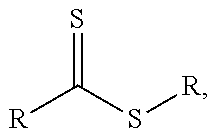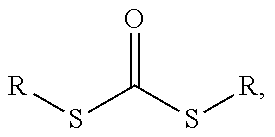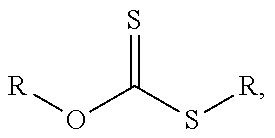Method for producing non-colored polyacrylate adhesive compounds with a narrow molar mass distribution
a polyacrylate adhesive and molar mass technology, applied in the direction of adhesives, ester polymer adhesives, adhesive types, etc., can solve the problems of unstable adhesive, environmental objection, and relatively expensive and inconvenient operation, and achieve the effect of high reaction ra
- Summary
- Abstract
- Description
- Claims
- Application Information
AI Technical Summary
Benefits of technology
Problems solved by technology
Method used
Image
Examples
examples
Test Methods
[0098]The following test methods were employed in order to evaluate both the technical adhesive properties and the general properties of the PSAs prepared.
Gel Permeation Chromatography GPC (Test A)
[0099]The average molecular weights Mn and Mw and the polydispersity P were determined using gel permeation chromatography. The eluent employed was THF with 0.1 vol % of trifluoroacetic acid. Measurement was carried out at 25° C. The preliminary column used was PSS-SDV, 5μ (5 μm), 103 Å (0.0103 μm) ID 8.0 mm×50 mm. Separation took place using the columns PSS-SDV, 5μ (5 μm), 103 Å (0.0103 μm) and also 105 Å (0.0105 μm) and 106 Å (0.0106 μm) each with ID 8.0 mm×300 mm. The sample concentration was 4 g / l, the flow rate 1.0 ml per minute. Measurement was made against PMMA standards.
example 1
[0112]A conventional reactor for free-radical polymerizations was charged with 32 g of trithiocarbonate-functionalized polystyrene (2), 442 g of 2-ethylhexyl acrylate, 4.5 g of acrylic acid and 0.12 g of Vazo 67® (from DuPont). After passing argon through for 20 minutes and degassing twice, the reactor was heated up to 70° C. and polymerization was effected for 16 h. For isolation, the batch was cooled to RT, and the PS-P(EHA / AA)-PS block copolymer was diluted to 50% with acetone and then coated onto a PET carrier 23 μm thick by means of a conventional coating bar and then dried at 120° C. for 15 minutes. The coatweight was 50 g / m2. The polymer has a pale yellowish color. GPC analysis: Mn=95 500 g / mol, Mw / Mn=2.24. Subsequently, testing was effected by test methods B and C (see table 1).
example 2
[0113]A reactor conventional for radical polymerizations was charged with 32 g of n-butyl acrylate, 442 g of 2-ethylhexyl acrylate, 4.5 g of acrylic acid, 1.40 g of 4-(benzothioylsulfanyl)-4-cyanopentanoic acid (5.00 mmol, Aldrich, CAS No. 201611-92-9), and 0.12 g of Vazo 67® (DuPont). After argon had been passed through the reactor for 20 minutes and the reator had been twice degassed, the reactor was heated to 70° C. with stirring and polymerization was carried out for 16 hours. For isolation the batch was cooled to room temperature, the polymer was diluted with acetone to 50%, 0.2 wt %, based on the polymer, of aluminum acetylacetonate (Aldrich, CAS No. 13963-57-0) was added, and the resulting compositions were then coated using a conventional bar coater on a 23 μm PET carrier, followed by drying at 120° C. for 15 minutes. The coatweight was 50 g / m2. The polymer has a reddish coloration. GPC analysis: (Mn=104 000 g / mol, Mw / Mn=2.09). Testing took place subsequently in accordance w...
PUM
| Property | Measurement | Unit |
|---|---|---|
| temperature | aaaaa | aaaaa |
| weight fraction | aaaaa | aaaaa |
| polydispersity | aaaaa | aaaaa |
Abstract
Description
Claims
Application Information
 Login to View More
Login to View More - R&D
- Intellectual Property
- Life Sciences
- Materials
- Tech Scout
- Unparalleled Data Quality
- Higher Quality Content
- 60% Fewer Hallucinations
Browse by: Latest US Patents, China's latest patents, Technical Efficacy Thesaurus, Application Domain, Technology Topic, Popular Technical Reports.
© 2025 PatSnap. All rights reserved.Legal|Privacy policy|Modern Slavery Act Transparency Statement|Sitemap|About US| Contact US: help@patsnap.com



